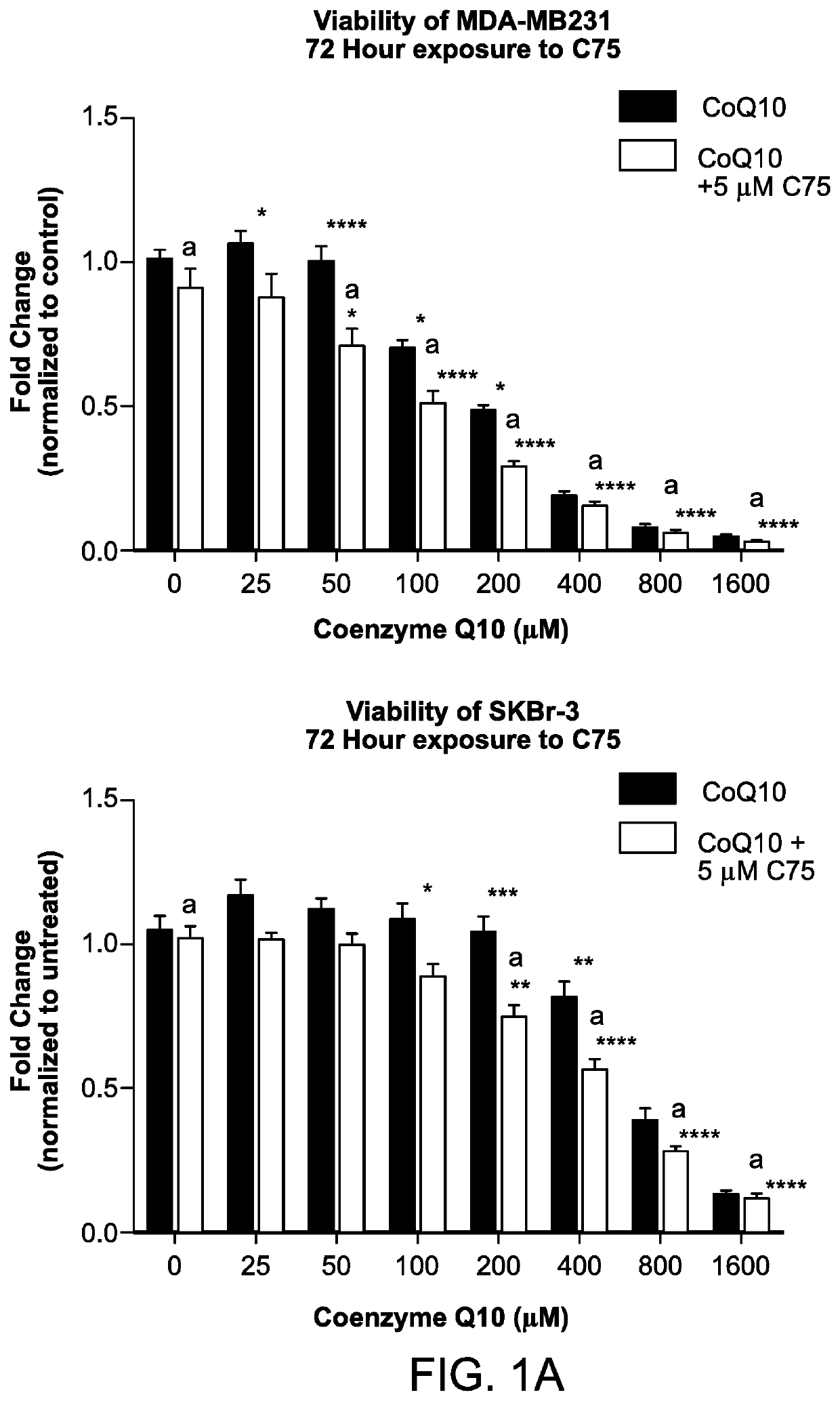Methods for the treatment of cancer using coenzyme q10 and fatty acid metabolism inhibitors
a technology of fatty acid metabolism and coenzyme q10, which is applied in the field of cancer treatment using coenzyme q10 and fatty acid metabolism inhibitors, can solve the problems of cancer patients suffering from chronic or acute pain, organ failure, lesions, etc., and achieves the improvement of the response of the oncological disorder to treatment, the effect of increasing the storage or degradation increasing the activity of fatty acid metabolism
- Summary
- Abstract
- Description
- Claims
- Application Information
AI Technical Summary
Benefits of technology
Problems solved by technology
Method used
Image
Examples
example 1
Effects of Coenzyme Q10 Alone or in Combination with Fatty Acid Metabolism Inhibitors on Cell Viability, Fatty Acid Metabolism Gene Expression, Glycerol Content and Fatty Acid Composition in Breast Cancer Cells
[0254]Cell viability was assessed in MDA-MB231 and SkBr-3 breast cancer cells exposed to Coenzyme Q10 alone or in combination with the fatty acid metabolism inhibitors C75, etomoxir, and trimetazidine, as well as a more pleiotropic fatty acid metabolism modulator, metformin. C75, etomoxir, and trimetazidine are selective inhibitors of specific enzymes in the fatty acid synthesis / metabolism pathway (fatty acid synthase (FASN), carnitine palmitoyltransferase I (CPT1), and long-chain 3-ketoacyl-CoA thiolase, respectively). Metformin is used clinically as an anti-diabetic agent to suppress glucose production by the liver; however, the mechanism of action remains incompletely understood. Metformin has multiple targets, all of which may contribute to its glucose lowering activity (e...
example 2
Effects of Coenzyme Q10 Alone or in Combination with Fatty Acid Metabolism Inhibitors on Cell Viability in Pancreatic Cancer Cells
[0260]Cell viability was next assessed in MIA PaCa-2 pancreatic cancer cells exposed to Coenzyme Q10 alone or in combination with the fatty acid metabolism inhibitors C75, etomoxir, trimetazidine, metformin, and the Stearoyl-CoA desaturase-1 (SCD-1) inhibitor A939572. The experiments were generally carried out similarly as the experiments described in Example 1. SCD-1 is an endoplasmic reticulum enzyme that catalyzes the formation of the monounsaturated fatty acids oleic acid and palmitoleic acid from stearoyl-CoA and palmitoyl-CoA. Oleic acid and palmitoleic acid are major components of membrane phospholipids, cholesterol esters and alkyl-diacylglycerol. Thus SCD-1 is a key enzyme in fatty acid metabolism. Inhibition of SCD-1 results in depletion of mono-unsaturated fatty acids and reduction of lipid storage. Results from these studies showed that pancre...
PUM
| Property | Measurement | Unit |
|---|---|---|
| Fraction | aaaaa | aaaaa |
| Fraction | aaaaa | aaaaa |
| Fraction | aaaaa | aaaaa |
Abstract
Description
Claims
Application Information
 Login to View More
Login to View More - R&D
- Intellectual Property
- Life Sciences
- Materials
- Tech Scout
- Unparalleled Data Quality
- Higher Quality Content
- 60% Fewer Hallucinations
Browse by: Latest US Patents, China's latest patents, Technical Efficacy Thesaurus, Application Domain, Technology Topic, Popular Technical Reports.
© 2025 PatSnap. All rights reserved.Legal|Privacy policy|Modern Slavery Act Transparency Statement|Sitemap|About US| Contact US: help@patsnap.com



